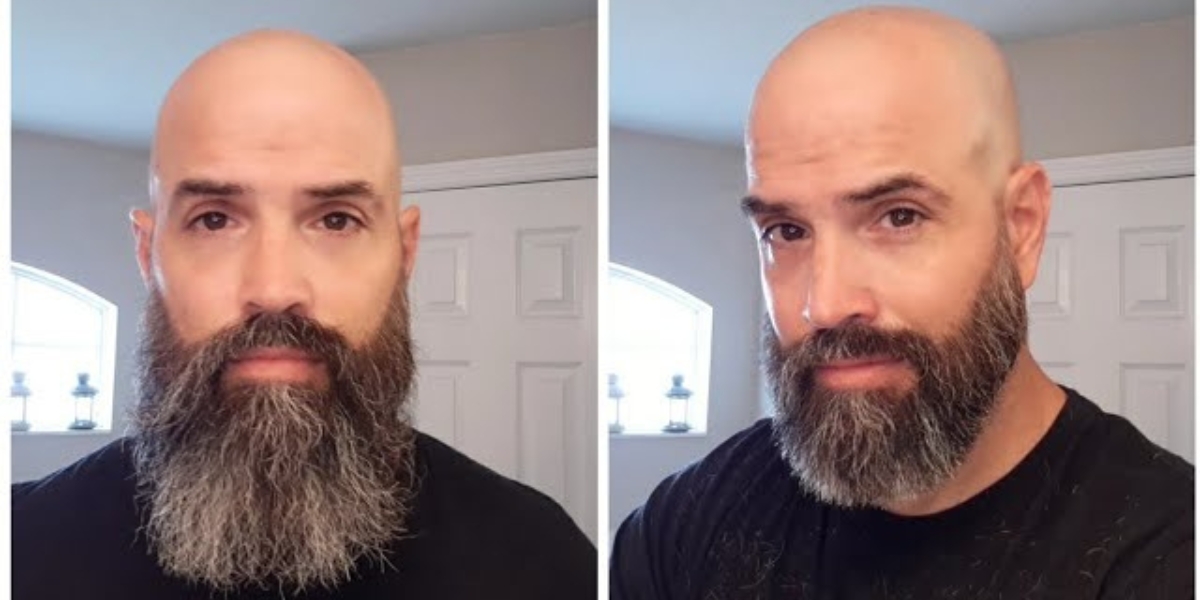Beards have been a symbol of masculinity and style for centuries. With different beard styles available, it’s important to understand the nuances between them. This article will compare two popular beard types: the tight beard and the loose beard. We’ll explore their characteristics, benefits, and how they stack up against each other to help you decide which style might be best for you.
What Is a Tight Beard?
A tight beard is a well-groomed beard where the hair lies close to the skin, creating a neat and defined look. This style is often characterized by a compact and orderly appearance, making it look sharp and polished.
Characteristics of a Tight Beard

Close-Knit Hair: The hair grows close to the skin, leaving little to no gaps or patches.
Neat and Defined Lines: The edges are meticulously shaped, often requiring regular trimming to maintain its form.
Uniform Length: The hair is kept at a consistent length for a uniform appearance.
Benefits of a Tight Beard
Professional Appearance: A tight beard often looks more polished, making it suitable for formal settings and professional environments.
Easy to Manage: With less volume and a more controlled shape, a tight beard can be easier to manage and maintain.
Less Itchiness: The close-cropped style may reduce the itchiness that sometimes accompanies a fuller beard.
How to Achieve a Tight Beard
Regular Trimming: Use a beard trimmer to keep the length uniform and edges well-defined.
Daily Grooming: Brush and comb your beard daily to ensure it remains neat.
Moisturize: Apply beard oil or balm to keep the hair healthy and reduce dryness.
Visit a Barber: For the best results, consider visiting a professional barber for precise shaping and maintenance.
What Is a Loose Beard?
A loose beard is characterized by a more relaxed and natural growth pattern. The hair tends to grow in a less uniform manner, giving it a fuller and often more rugged appearance.
Characteristics of a Loose Beard
Fuller Growth: The hair grows outwards and may not lie as close to the skin.
Less Defined Edges: The edges are often less sharply defined, giving a more casual look.
Varied Length: The length may vary across different areas, creating a more natural and less controlled appearance.
Benefits of a Loose Beard
Natural Look: A loose beard often appears more natural and less manicured, which can be appealing for a more relaxed style.
Less Frequent Maintenance: With less focus on precise shaping, a loose beard generally requires less frequent grooming.
Versatility: A loose beard can adapt to various styles and looks, offering more flexibility.
How to Embrace and Style a Loose Beard
Let It Grow: Allow your beard to grow out without frequent trimming to achieve a fuller look.
Brush Regularly: Use a beard brush to manage tangles and keep the hair looking tidy.
Use Beard Balm: Apply beard balm to add some control and shape while keeping the natural look.
Shape Occasionally: Trim only as needed to avoid excessive shaping and maintain the natural style.
Aesthetic Differences
Tight Beard: Offers a polished and professional look with well-defined edges and a clean appearance.
Loose Beard: Provides a rugged, natural look with a fuller appearance and less precise edges.
Maintenance and Grooming

Tight Beard: Requires regular trimming, daily grooming, and occasional professional shaping to maintain its look.
Loose Beard: Requires less frequent trimming and maintenance, focusing more on overall health and less on precise shaping.
Comfort and Feel
Tight Beard: May feel more comfortable for those who prefer a controlled look and less beard hair against the skin.
Loose Beard: Can be more comfortable for those who enjoy a fuller beard and don’t mind the natural growth pattern.
Popularity and Trends
Tight Beard: Often favored in professional and formal settings, making it a popular choice for business professionals.
Loose Beard: Popular among those who prefer a more relaxed and casual appearance, and it’s often seen in casual or creative environments.
Choosing the Right Beard Style for You
Factors to Consider
Face Shape: Different beard styles complement various face shapes. A tight beard can enhance angular features, while a loose beard may balance out a more rounded face.
Lifestyle: Consider your daily activities and work environment. A tight beard may suit a professional setting, while a loose beard can be more fitting for casual or creative roles.
Personal Preference: Ultimately, your preference will guide your choice. Whether you enjoy the polished look of a tight beard or the relaxed style of a loose beard, choose what makes you feel confident and comfortable.
How to Decide Between a Tight and Loose Beard
Try Both Styles: Experiment with different beard styles to see which one suits you best.
Consult a Barber: A professional can offer advice on which style complements your facial features and lifestyle.
Consider Your Maintenance Routine: Evaluate how much time and effort you’re willing to invest in beard grooming.
Beard Care Tips for Both Styles

Clean Regularly: Wash your beard regularly to remove dirt and oils.
Moisturize: Use beard oil or balm to keep the hair and skin hydrated.
Trim as Needed: Regular trimming helps maintain the shape and health of your beard.
Common Issues and Solutions
Itchiness: Use beard oil to soothe the skin and reduce itchiness.
Dryness: Apply beard balm to prevent dryness and keep the hair soft.
Uneven Growth: Trim regularly and use beard oil to promote even growth.
Techniques for Tight Beards
Outline the Edges: Use a trimmer to define the edges of your beard for a clean look.
Even Length: Trim to maintain a uniform length across the beard.
Regular Maintenance: Visit a barber for precise shaping and maintenance.
Techniques for Loose Beards
Embrace Natural Growth: Allow your beard to grow out without excessive trimming.
Maintain Shape: Trim occasionally to keep the overall shape but avoid over-shaping.
Manage Volume: Use beard balm to control the volume and add some shape.
Transitioning Between Styles
Gradual Change: Slowly adjust your trimming routine to shift from a tight to a loose beard or vice versa.
Consult a Professional: Seek advice from a barber to help with the transition and ensure a smooth change.
Interviews with Individuals Who Prefer Tight Beards
I prefer a tight beard because it gives me a polished, professional look that suits my office environment. Regular trimming and maintenance keep it looking sharp and well-defined.” – Alex, Marketing Executive
Interviews with Individuals Who Prefer Loose Beards
I love my loose beard because it feels natural and requires less maintenance. It fits my casual lifestyle and gives me a relaxed, easygoing appearance.” – Chris, Freelance Writer
Conclusion
Both tight and loose beards offer unique benefits and styles. A tight beard is neat and professional, while a loose beard provides a natural and rugged look. Choosing between them depends on your face shape, lifestyle, and personal preference.
FAQs
Q1. What’s the main difference between a tight beard and a loose beard?
A tight beard is characterized by its close-knit hair growth and well-defined edges, creating a neat and polished look. In contrast, a loose beard features a fuller, more relaxed growth pattern with less precise edges, offering a more natural and rugged appearance.
Q2. Which beard style is easier to maintain: tight or loose?
Generally, a tight beard requires more maintenance due to the need for regular trimming and precise shaping to keep the edges clean. A loose beard tends to be easier to maintain with less frequent trimming, focusing more on overall health rather than exact shaping.
Q3. Can I transition from a loose beard to a tight beard?
Yes, you can transition from a loose beard to a tight beard by gradually trimming and shaping it to achieve the desired look. Visiting a professional barber can help you make this transition smoothly.
Q4. How often should I trim a tight beard?
A tight beard usually requires trimming every 1-2 weeks to maintain its shape and defined edges. Regular maintenance helps keep the beard looking sharp and well-groomed.
Q5. Does a loose beard require special products?
While a loose beard may not require as many products as a tight beard, using beard oil or balm can help keep the hair soft and manageable. These products also help with overall beard health and appearance.
Q6. What are the benefits of having a tight beard?
A tight beard offers a professional and polished look, is easier to manage and maintain, and may reduce itchiness compared to a fuller beard. It’s often preferred in formal or business settings.
Q7. What are the benefits of having a loose beard?
A loose beard provides a natural, relaxed look and generally requires less frequent grooming. It’s versatile and suits a casual or creative lifestyle, offering a more rugged appearance.
Q8. Can I have a tight beard if I have patchy growth?
Yes, you can still maintain a tight beard with patchy growth by carefully shaping and trimming the beard to manage the appearance. Beard products and proper grooming can help improve the look of patchy areas.
Q9. How can I prevent my tight beard from becoming itchy?
To prevent itchiness, use beard oil or balm to moisturize both the beard hair and the skin underneath. Regular washing and conditioning also help keep the beard and skin healthy.
Q10. What tools are recommended for grooming a tight beard?
For grooming a tight beard, a high-quality beard trimmer, a beard brush, and beard oil or balm are essential. A good trimmer helps with precise shaping, while a brush helps manage and style the beard.
Q11. How can I make my loose beard look more styled?
To make a loose beard look more styled, use beard balm to add some control and shape. Regular brushing and occasional trimming can help maintain a tidy appearance while embracing the natural look.
Q12. Is it possible to switch between a tight and loose beard style frequently?
Yes, you can switch between beard styles, but it may require adjusting your grooming routine and letting your beard grow or be trimmed as needed. Be prepared for some time and patience during the transition.

